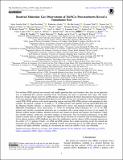Resolved molecular gas observations of MaNGA post-starbursts reveal a tumultuous past
Abstract
Post-starburst galaxies (PSBs) have recently and rapidly quenched their star-formation; thus, they are an important way to understand how galaxies transition from star-forming late types to quiescent early types. The recent discovery of large cold gas reservoirs in PSBs calls into question the theory that galaxies must lose their gas to become quiescent. Optical Integral Field Spectroscopy (IFS) surveys have revealed two classes of PSBs: central PSB (cPSB) galaxies with central quenching regions and ring PSB (rPSB) galaxies with quenching in their outskirts. We analyze a sample of 13 nearby (z < 0.1) PSBs with spatially resolved optical IFS data from the Mapping Nearby Galaxies at Apache Point Observatory (MaNGA) survey and matched resolution Atacama Large (sub-)Millimeter Array (ALMA) observations of 12CO(1-0). Disturbed stellar kinematics in 7/13 of our PSBs and centrally concentrated molecular gas is consistent with a recent merger for most of our sample. In galaxies without merger evidence, alternate processes may funnel gas inwards and suppress star-formation, which may include outflows, stellar bars, and minor mergers or interactions. The star-formation efficiencies of the post-starburst regions in nearly half our galaxies are suppressed while the gas fractions are consistent with star-forming galaxies. AGN feedback may drive this stabilization, and we observe AGN-consistent emission in the centers of 5/13 galaxies. Finally, our central and ring PSBs have similar properties except the ionized and molecular gas in central PSBs is more disturbed. Overall, the molecular gas in our PSBs tends to be compact and highly disturbed, resulting in concentrated gas reservoirs unable to form stars efficiently.
Citation
Otter , J A , Rowlands , K , Alatalo , K , Leung , H-H , Wild , V , Luo , Y , Petric , A O , Sazonova , E , Stark , D V , Heckman , T , Davis , T A , Ellison , S , French , K D , Baker , W , Bluck , A F L , Lanz , L , Lin , L , Liu , C , López Cobá , C , Masters , K L , Nair , P , Pan , H , Riffel , R A , Scudder , J M , Smercina , A , van de Voort , F & Weaver , J R 2022 , ' Resolved molecular gas observations of MaNGA post-starbursts reveal a tumultuous past ' , Astrophysical Journal , vol. 941 , no. 1 , 93 . https://doi.org/10.3847/1538-4357/ac9dee
Publication
Astrophysical Journal
Status
Peer reviewed
ISSN
0004-637XType
Journal article
Description
Funding: JO, YL, KA, KR, and ES have been partially funded by Space Telescope Science Institute Director’s Discretionary Research Fund grants D0101.90241, D0101.90276, D0101.90262, D0101.90281, D0101.90296, HST grants GO-14715.021, GO-14649.015, and Chandra grant GO7-18096A. JO acknowledges support from NRAO under grant No. SOSPA7-027. LL thanks the support from the Academia Sinica under the Career Development Award CDA107-M03 and the Ministry of Science & Technology of Taiwan under the grant MOST 111-2112-M-001-044. HAP acknowledges support by the National Science and Technology Council of Taiwan under grant 110-2112-M-032-020-MY3. WB acknowledges support from the Science and Technology Facilities Council (STFC). The Cosmic Dawn Center is funded by the Danish National Research Foundation under grant No. 140. RAR acknowledges the support from Conselho Nacional de Desenvolvimento Científico e Tecnológico and Fundação de Amparo à pesquisa do Estado do Rio Grande do Sul. TAD acknowledges support from the UK Science and Technology Facilities Council through grants ST/S00033X/1 and ST/W000830/1. FvdV was supported by a Royal Society University Research Fellowship.Collections
Items in the St Andrews Research Repository are protected by copyright, with all rights reserved, unless otherwise indicated.

